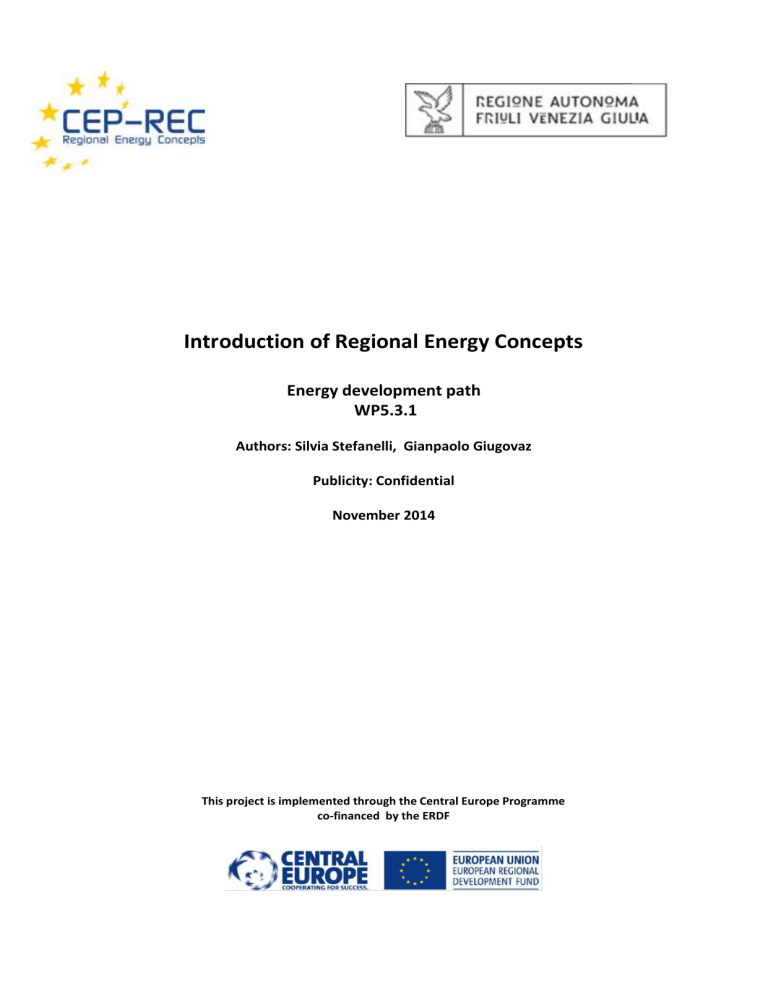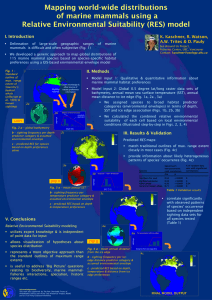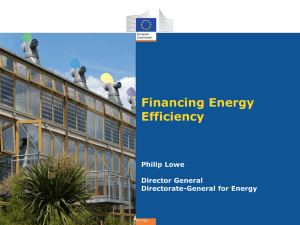development path of the Region - CEP-REC

Introduction of Regional Energy Concepts
Energy development path
WP5.3.1
Authors: Silvia Stefanelli, Gianpaolo Giugovaz
Publicity: Confidential
November 2014
This project is implemented through the Central Europe Programme co-financed by the ERDF
Task 5.3.1
Index
Scenario 1. Trend prolongation up to 2020 - CO2 Emissions
Scenario 2. Energy saving – prolongation trend
Scenario 3. RES prolongation trend
Scenario 3. RES activation trend
List of Tables and Figures
Fig.1 Italian 2020 CO2, RES and energy efficiency objectives by 2020
Fig.2 CO2 emissions and the contribution of the sector to the decarbonisation scenarios
Fig.3 Fig 3.CO2 emission trend up to 2010 in the Friuli Venezia Giulia Region
Fig.4 The evolutin of carboon intensity until 2050
Fig.5 RES –Electricity prolongation trend up to 2020
Fig.6 RES-Heat prolongation trend
Fig. 7 RES heat activation scenario up to 2020
Fig.8 RES growth up to 2020
Fig. 9 Renewable resources in the FVG Region
Fig. 10 RES free potential in the FVG Region
Table 1. RES-Heat prolongation trend scenario for each RES source in comparison to
RES – heat 2020 regional targets
Table 2. RES-Heat activation trend scenario for each RES source in comparison to
RES –heat 2020 target
3sCE417P3
Introduction of Regional Energy Concepts 2
Task 5.3.1
Scenario 1. Trend prolongation up to 2020 - CO2 emissions
As all the energy measures eventually can be turned into CO2 savings, an analysis of trends of CO2 emissions is paramount to understand the decarbonisation of the economy at national level and in the concept region.
At regional level the moment long term scenarios up to 2020 are based on ARPA , the
Regional Environmental Protection Agency energy evaluations and assessments.
Arpa energy scenarios are based on assumptions scaled down at regional level from the
National Energy Strategy and ENEA (National Energy Research Agency) scenarios for
Italy. The national outlook considers the 20/20/20 targets assigned to Italy. At the moment data from ARPA are not available in an inventory but only as figures and graphs, so it has not be possible to include them in the CEP REC balance sheet and development path.
They are based on national forecast scaled down at regional level considering the GDP, population, family size, costs of traditional fossil fuel sources, environmental and energy policies, energy intensity of lifestyles.
Only the CO2 scenario without any additional measure has been described as future energy supporting measures and policies are being discussed in the ongoing Regional energy plan that will be finalized and adopted in 2015.
However it is paramount to understand future regional scenarios also to look unto the national energy landscape up to 2020. In fact regional long term provisions will reflect national targets and goals on energy as shown in Figure 1. Figure1 shows that CO2 emission measured on baseline emission of 2005 will decrease by 21% in 2020.
Fig.1 Italian 2020 CO2, RES and energy efficiency objectives by 2020
Italy CO2 reductions objectives, million tonnes
Italy RES increase (% in final energy consumption)
Italy energy efficiency targets
( Mtep)
Source: Italian Energy Strategy 2012 – Ministery of Economic Development
3sCE417P3
Introduction of Regional Energy Concepts 3
Task 5.3.1
In the long term the Italian reference scenario shows that, due to the economic crisis and the policies in place, it is actually possible to achieve the goal of 20% reduction of CO2 emissions in 2020 as Fig 1. However in the long run Fig 2 shows that policies implemented to date are not able to guarantee the decarbonisation called for in the Roadmap 2050.
According to the results of a scenario, the goal of reducing emissions (-80% CO2 compared to
1990) is technologically and economically feasible, provided it is a near-total decarbonisation of the processes of electricity generation (-97% in 2050 compared to reference scenario, with a differential emission of 96 Mt CO2). This can be made possible by the use of renewables, smart grids by making it possible to exploit its potential and CO2 Capture and Storage (CCS).
At the same time will have priority to efficiency technologies, in particular end-use, in order to ensure a more sustainable use of energy and reduce energy requirements. An important role is also played by the transport sector, thanks to the penetration of electric vehicles, alternative fuels, environmentally sustainable and shift-modal, could contribute to 26% reduction recorded in 2050 compared to an evolution emissive trend
Fig. 2 CO2 emissions and the contribution of the sector to the decarbonisation scenarios
Source: ENEA 2012
However at regional level the scenario looks different than the national one. CO2 emissions in the last
20 years increased steadily from 1990 in all sectors but industry as Fig 3 shows . According to recent analysis CO2 emissions will grow up to 2015 and only after that they will stabilize. The underlying reasons of growing green house gas emissions at regional level are due to:
The Region is a net secondary energy exporter, therefore its GHG balance factors in also emissions associated with exported energy, consumed elsewhere
The regional territory works as a transport corridor to eastern Europe and viceversa, therefore fuel consumption but in part due to transfer transport not related to a local citizens demand.
3sCE417P3
Introduction of Regional Energy Concepts 4
Task 5.3.1
So GHG emissions at regional level, unless specific measures will be adopted and implemented in the most energy intensive sectors or carbon sequestration measures adopted to strengthen the carbon sink capacity of forests or reduce emissions in the agriculture sector.
Fig 3. CO2 emission trend up to 2010 in the Friuli Venezia Giulia Region
Energy
Domestic
Transport
Industry
Source: Arpa 2014
Scenario 2: Energy saving and energy efficiency
National outlook
The national system to support energy efficiency is substantially based on the mechanism of white certificates on mandatory minimum standards for buildings, equipment and vehicles, as well as a mechanism that grants a 55% tax rebate for energy efficiency domestic interventions.
At national level a trend prolongation or reference scenario shown in Fig4 envisages a final energy demand reduction by 2050. Albeit to varying degrees, this reduction could be achieved in all end-use sectors: the difference between the two scenarios, the civil sector accounts for more than half the long-term, transport to a third party, the industry with the remaining 15%.
The significant reductions in final consumption scenario envisaged by the „implemented scenario“ are also the result of the electrification of the most driven the evolution of
Reference, reaching 60% in 2050 in the civil sector, 46% in industry and 12% in transport .
The buildings, which account for over one third of the energy consumption of our country, are in this sense perhaps the main sector of intervention, given the several technological options already available and the relatively short life of many end-use devices. A strategy for upgrading the energy efficiency of the building stock Italian appears to be a key ingredient in the strategy to decarbonise considered. Even in the transport sector there are numerous solutions for configurations more sustainable from an environmental point of view. The implemented scenario shows the possibility of reducing consumption to 40% projected as oppposed tot he trend prolongation Scenario in 2050. The reduction outlined by the trend
3sCE417P3
Introduction of Regional Energy Concepts 5
Task 5.3.1 prolongation scenario would be due primarily to transport as a result of the diffusion of hybrid vehicles, pure electric and plug-in, improving the performance of traditional fuel vehicles, together with the hypothesis of the mobility shift of passengers to the public transport . In the industrial sector energy efficiency is certainly an option that allows a trajectory environmentally and economically sustainable.
Fig.4 The evolution of carbon intensity in Italy until 2050
Trend prolongation scnearscenario
Implemented scenario
Source: ENEA 2012
Regional outlook
The future regional energy strategy plan will be based on the ongoing regional energy plan.
This policy tool started off in March 2014 when the Regional Government approved the
Environmental Preliminary Report that was submitted to official stekeholders (Ministries,
Parks,
Provinces etc) for comments.
The timeline of the plan is to finish it by July 2015. The plan will include full energy
assessment, energy offer and demand, objectives and measures to meet them, energy scenarios and socio economic impacts . It will also interface with the old energy plan which expired in 2010 as well as the regional energy law 19/2012, other plans ( mobility, territory, waste, environment etc) and national and European energy provisions.
The objectives of the regional energy strategy as laid out in the Preliminary report of the plan are the following and they will define the energy scenario:
•
Support energy distributed generation
•
Support to energy from RES
• Environmental improvement and GHG emissions reduction
3sCE417P3
Introduction of Regional Energy Concepts 6
Task 5.3.1
•
Energy innovation, R&D and energy security
• Support to energy competition and to low energy prices
•
Increase energy efficiency consistently with EU and national provisions
At the moment it is therefore not possible to quantify the impact of the overall energy efficiency measures and of additional measures. However it is reasonable to think that as the main supporting measures are based on national economic instruments, the regional trend will follow closely the national scenarios.
Scenario 3. RES prolongation scenario
One of the key features of the regional energy landscape is the high free and untapped renewables potential in a diversified portfolio of sources that include firstly geothermal heat, solar electric and solar thermal, field agriculture byproducts, waste biomass and hydropower as Fig.9 and 10 show. At the moment the region has not laid out yet a RES strategy to define a priority of one source over another one, although the current RES exploitation highlights some priorities. In fact among all RES so far only RES electricity have been strongly supported and shown a remarkable increase.The RES-E in 2012 share accounted for 22% of total electricity consumption rate regional level, well above the 12,7% RES target by 2020 that will include RES-Electricity and RES-Heat shown in Fig.8. Although the RES-E and RES-H mix to reach the target will depend on regional strategies and can be flexible, it is reasonable to think that the main efforts up to 2020 will be focused on thermal renewables and the reduction of energy consumption to meet the 12,7 RES target.
The spontaneous growth of RES-Electricity in shown in Figure 5.
Fig.5 RES –Electricity prolongation trend up to 2020 in the FVG Region
3sCE417P3
Introduction of Regional Energy Concepts 7
Task 5.3.1
Burden sharing target 20
20
Solar PV
Hydropower
Biomass
According to a recent regional survey the regional RES Burden sharing target will be met
under a development of a scenario without additional measures.
A key role in meeting the RES-heat target will be played by biomass –heat that will cover as much as 96% of RES-Heat by 2020 as Fig 6 shows, particularly in the residential sector . In the prolongation trend shown in Table 1 it is supposed that biomass heat will increase only by
4,5%, excluding biomass distributed heat
Fig.6 RES-Heat prolongation trend
3sCE417P3
Introduction of Regional Energy Concepts 8
Task 5.3.1
Biomass
Source: CETA 2013
Table 1. RES-Heat prolongation trend scenario for each RES source in comparison to RES – heat 2020 regional targets
3sCE417P3
Introduction of Regional Energy Concepts 9
Task 5.3.1
RES-Heat Source
Distributed biomass heat
Biomass
Solar thermal
Geothermal
Heat pumps
Biomethan
Total
RES-Heat production
Burden sharing target
National strategy <
Burden sharing target
National strategy >
Source: CETA 2013
As Fig.6 and Table 1 show, solar thermal, geothermal energy and heat pumps will play a limited role in RES-heat production respectively with a share of 2,6%, 0,3 % and 1,1% in the overall RES-heat mix. However for solar thermal it is expected a growth of 103% (in
2011solar thermal production accounted for 3,9 ktep) while for heat pumps a remarkable growth of 3300 % (in 2011 heat pumps amounted to 0,1 ktep).
Scenario 3. Activation of Regional RES
As shown in the RES prolongation trend scenario the regional RES target it will presumably already met under a prolongation trend. Among the renewables that have the highest free potential as shown in Fig. the thermal sources with the highest free potential like geothermal won’t play the lion’s share. Biomass sources instead will play a key role like in the prolongation trend scenario. The main difference will be represented by a higher increase and share of distributed biomass heat, solar thermal, heat pumps and geothermal over traditional biomass heat generation, namely in domestic boilers.
RES heat activation scenario
Fig. 7 RES heat activation scenario up to 2020
3sCE417P3
Introduction of Regional Energy Concepts 10
Task 5.3.1
Source: CETA 2013
Table 2. RES-Heat activation trend scenario for each RES source in comparison to RES – heat 2020 target
3sCE417P3
Introduction of Regional Energy Concepts 11
Task 5.3.1
RES-Heat Source
Distributed biomass heat
Biomass
Solar thermal
Geothermal
Heat pumps
Biomethan
Total
Burden sharing target
<
Source: CETA 2013
Fig.8 RES growth up to 2020
3sCE417P3
Introduction of Regional Energy Concepts 12
Task 5.3.1
Fig. 9 Renewable resources in the FVG Region
REGIONAL RESOURCES [MWh / a]
CURRENT USE TOTAL POTENTIAL
3.000.000 MWh/a
2.500.000 MWh/a
2.000.000 MWh/a
1.500.000 MWh/a
1.000.000 MWh/a
500.000 MWh/a
0 MWh/a
Fig. 10 RES free potential in the FVG Region
FREE POTENTIALS [MWh/a]
FREE POTENTIALS
3.000.000 MWh/a
2.500.000 MWh/a
2.000.000 MWh/a
1.500.000 MWh/a
1.000.000 MWh/a
500.000 MWh/a
0 MWh/a
ACTIVATION
3sCE417P3
Introduction of Regional Energy Concepts 13







